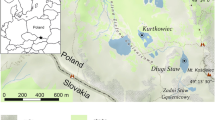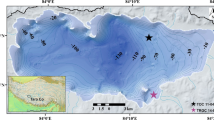Abstract
We inferred the temperature and environmental conditions of Smreczynski Staw Lake in the Tatra Mountains, southern Poland, from a sediment record covering the last 1,500 years. Paleobiological methods (cladocera, chironomid, and diatom analyses) were used together with sedimentological analysis and dating. These studies provide new information about the timing and character of climate fluctuations during the Little Ice Age (LIA). The Medieval Warm Period ended in the Tatra region at the beginning of the thirteenth century, followed by the first episode of the LIA. The LIA was a relatively long but unstable period. The first part of the LIA was cold in the Tatra Mountains, without evidence of increasing precipitation, while the second part, after AD 1540, was cold and humid. The LIA terminated in the Tatra Mountains at the beginning of the twentieth century, although some aspects of its climatic and sedimentological regime continued until the 1920s. We also found some evidence of warming and acidification during the twentieth century.






Similar content being viewed by others
References
Anderson NJ (2000) Miniview: diatoms, temperature and climatic change. Eur J Phycol 35:307–314
Appleby PG (2001) Chronostratigraphic techniques in recent sediments. In: Last WM, Smol JP (eds) Tracking environmental changes using lake sediments. Vol. 1: basin analysis, coring, and chronological techniques. Kluwer, Dordrecht
Battarbee RW (1986) Diatom analysis. In: Berglund BE (ed) Handbook of Holocene palaeoecology and palaeohydrology. Wiley, Chichester, UK, pp 527–570
Birks HJB, Line JM, Juggins S, Stevenson AC, ter Braak CJF (1990) Diatoms and pH reconstruction. Philos Trans R Soc Lond B 327:263–278. doi:10.1098/rstb.1990.0062
Blass A, Grosjean M, Troxler A, Sturm M (2007) How stable are twentieth-century calibration models? A high-resolution summer temperature reconstruction for the eastern Swiss Alps back to AD 1580 derived from proglacial varved sediments. Holocene 17:51–63. doi:10.1177/0959683607073278
Bloom AM, Moser KA, Porinchu DF, MacDonald GM (2003) Diatom-inference models for surface-water temperature and salinity developed from a 57-lake calibration set from Sierra Nevada, California, USA. J Paleolimnol 29:235–255. doi:10.1023/A:1023297407233
Bonnefille R, Mohammed U (1994) Pollen-inferred climatic fluctuations in Ethiopia during the last 3000 years. Palaeogeogr Palaeoclimatol Palaeoecol 109:331–343. doi:10.1016/0031-0182(94)90183-X
Bradley RS, Jones PD (1993) ‘Little ice age’ summer temperature variations: their nature and relevance to recent global warming trends. Holocene 3:367–376. doi:10.1177/095968369300300409
Briffa KR, Jones PD, Schweingruber FH, Osborn TJ (1998) Influence of volcanic eruptions on Northern Hemisphere summer temperature over the past 600 years. Nature 393:450–454. doi:10.1038/30943
Bronk Ramsey C (1995) Radiocarbon calibration and analysis of stratigraphy: the OxCal program. Radiocarbon 37:425–430
Bronk Ramsey C (2001) Development of the radiocarbon program OxCal. Radiocarbon 43:355–363
Cameron NG, Birks HJB, Jones VJ, Berge F, Catalan J, Flower RJ, Garcia J, Kawecka B, Koinig KA, Marchetto A, Sánchez-Castillo P, Schmidt R, Šiško M, Solovieva N, Štefková E, Toro M (1999) Surface-sediment and epilithic diatom pH calibration sets for remote European mountain lakes (AL:PE Project) and their comparison with the Surface Waters Acidification Programme (SWAP) calibration set. J Paleolimnol 22:291–317. doi:10.1023/A:1008025928509
Campbell ID, McAndrews JH (1993) Forest disequilibrium caused by rapid Little Ice Age cooling. Nature 366:336–338. doi:10.1038/366336a0
Cleveland WS, Devlin SJ (1988) Locally-weighted regression: an approach to regression analysis by local fitting. J Am Stat Assoc 83:596–610. doi:10.2307/2289282
Crowley TJ (2000) Causes of climate changes over the past 1000 years. Science 289:270–277. doi:10.1126/science.289.5477.270
Curtis JC, Barbieri A, Camarero L, Gabathuler M, Galas J, Hanselmann K, Kopaček J, Mosello R, Nickus U, Rose N, Stuchlík E, Thies H, Ventura M, Wright R (2002) Application of static critical load models for acidity to high mountain lakes in Europe. Water Air Soil Pollut Focus 2:115–126. doi:10.1023/A:1020142323399
Eddy JA (1976) The maunder minimum. Science 192:1189–1201. doi:10.1126/science.192.4245.1189
Flössner D (2000) Die Haplopoda und Cladocera (ohne Bosminidae) Mitteleuropas. Backhuys, Leiden, 428 pp
Flynn WW (1968) The determination of low-levels of polonium-210 in environmental materials. Anal Chim Acta 43:221–227. doi:10.1016/S0003-2670(00)89210-7
Ford J (1986) The recent history of a naturally acidic lake (Cone Pond, N.H.). In: Smol JP, Battarbee RW, Davis RB, Meriläinen J (eds) Diatoms and lake acidity. W. Junk, Dordrecht, pp 131–148
Frey DG (1986) Cladocera analysis. In: Berglund BE (ed) Handbook of Holocene palaeoecology and palaeohydrology. Wiley, Chichester, UK, pp 667–692
Huttunen P, Meriläinen J (1986) Applications of multivariate techniques to infer limnological conditions from diatom assemblages. In: Smol JP, Battarbee RW, Davis RB, Meriläinen J (eds) Diatoms and lake acidity. W. Junk, Dordrecht, pp 201–211
Hyvärinen H, Alhonen P (1994) Holocene lake-level changes in the Fennoscandian tree-line region, western Finnish Lapland: diatom and cladoceran evidence. Holocene 4:251–258. doi:10.1177/095968369400400304
Jones PD, Briffa KR, Schweingruber FH (1995) Tree-ring evidence of the widespread effects of explosive volcanic eruptions. Geophys Res Lett 22:1333–1336. doi:10.1029/94GL03113
Jones PD, Osborn TJ, Briffa KR (2001) The evolution of climate over the last millennium. Science 292:662–667. doi:10.1126/science.1059126
Juggins S (2001) The European diatom database, User Guide, Version 1.0, 72 pp
Kawecka B, Galas J (2003) Diversity of epilithic diatoms in high mountain lakes under the stress of acidification (Tatra Mountains, Poland). Ann Limnol 39:239–253. doi:10.1051/limn/2003019
Koinig KA, Schmidt R, Sommaruga-Wögrath S, Tessadri R, Psenner R (1998) Climate change as the primary cause for pH shifts in a high alpine lake. Water Air Soil Pollut 104:167–180. doi:10.1023/A:1004941013924
Kopáček J, Stuchlík E, Hardekopf D (2006) Chemical composition of the Tatra Mountain lakes: recovery from acidification. Biologia (Bratisl) 61(Suppl 18):S21–S33
Korhola A, Weckström J, Holmström L, Erästö P (2000) A quantitative Holocene climatic record from diatoms in Northern Fennoscandia. Quat Res 54:284–294. doi:10.1006/qres.2000.2153
Köster D, Pienitz R (2006) Seasonal diatom variability and paleolimnological inferences—a case study. J Paleolimnol 35:395–416. doi:10.1007/s10933-005-1334-7
Kotarba A (1993–1994) Record of Little Ice Age in lacustrine sediments of the Morskie Oko Lake, High Tatra Mountains. Stud Geomorph Carpath Balcan 27–28:61–69
Kotarba A (1996) Sedimentation rates in the High Tatra lakes during the Holocene—geomorphic interpretation. Stud Geomorph Carpath Balcan 30:51–59
Kotarba A (2004) Zdarzenia geomorfologiczne w Tatrach Wysokich podczas małej epoki lodowej. In: Kotarba A (ed) Rola małej epoki lodowej w przekształcaniu środowiska przyrodniczego Tatr. Prace Geograf PAN, 197:9–57
Kotarba A (2006) The Little Ice Age in the High Tatra Mountains. Stud Quat 23:47–53
Krammer K, Lange-Bertalot H (1986) Süßwasserflora von Mitteleuropa. Bacillariophyceae. I. Teil: Naviculaceae. Gustav Fisher Verlag, Stuttgart, 876 pp
Krammer K, Lange-Bertalot H (1988) Süßwasserflora von Mitteleuropa. Bacillariophyceae. 2. Teil: Bacillariaceae, Epithemiaceae, Surirellaceae. Gustav Fisher Verlag, Stuttgart, 596 pp
Krammer K, Lange-Bertalot H (1991a) Süßwasserflora von Mitteleuropa. Bacillariophyceae. 3. Teil: Centrales, Fragilariaceae, Eunotiaceae. Gustav Fisher Verlag, Stuttgart, 576 pp
Krammer K, Lange-Bertalot H (1991b) Süßwasserflora von Mitteleuropa. Bacillariophyceae. 4. Teil: Achnanthaceae, Kritische Ergäzungen zu Navicula (Lineolatae) und Gomphonema Gesamtliteraturverzeichnis Teil 1–4. Gustav Fisher Verlag, Stuttgart, 436 pp
Lange-Bertalot H, Metzeltin D (1996) Ecology—diversity—taxonomy. Indicators of oligotrophy—800 taxa representative of three ecologically distinct lake types. In: Lange-Bertalot H (ed) Iconographia diatomologica 2. Koeltz Scientific Books, Koenigstein, 390 pp
Lara A, Villalba R (1993) A 3620-year temperature record from Fitzroya cupressoides tree ring in southern South. Am Sci 260:1104–1106
Lotter AF, Birks HJB, Hofmann W, Marchetto A (1997) Modern diatom, cladocera, chironomid, and chrysophyte cyst assemblages as quantitative indicators for the reconstruction of past environmental conditions in the Alps. I. Climate. J Paleolimnol 18:395–420. doi:10.1023/A:1007982008956
Lozano-García MD, Caballero M, Ortega B, Rodríguez A, Sosa S (2007) Tracing the effects of the Little Ice Age in the tropical lowlands of eastern Mesoamerica. Proc Natl Acad Sci USA 104:16200–16203. doi:10.1073/pnas.0707896104
MacKenzie AB, Logan EM, Cook GT, Pulford ID (1998) Distributions, inventories and isotopic composition of lead in Pb-210-dated peat cores from contrasting biogeochemical environments: implications for lead mobility. Sci Total Environ 223:25–35. doi:10.1016/S0048-9697(98)00302-7
Mann ME, Bradley RS, Hughes MK (1998) Global-scale temperature patterns and climate forcing over the past six centuries. Nature 392:779–787. doi:10.1038/33859
Mann ME, Bradley RS, Hughes MK (1999) Northern hemisphere temperatures during the past millennium: inferences, uncertainties and limitations. Geophys Res Lett 26:759–762. doi:10.1029/1999GL900070
Moberg A, Sonechkin DM, Holmgren K, Datsenko NM, Karlén W (2005) Highly variable Northern Hemisphere temperatures reconstructed from low- and high-resolution proxy data. Nature 433:613–617. doi:10.1038/nature03265
Niedźwiedź T (2004) Rekonstrukcja warunków termicznych w Tatrach od 1550 roku. In: Kotarba A (ed) Rola małej epoki lodowej w przekształcaniu środowiska przyrodniczego Tatr. Prace Geograf PAN, 197:57–88
Pienitz R, Smol JP, Birks HJB (1995) Assessment of freshwater diatoms as quantitative indicators of past climatic change in the Yukon and Northwest Territories, Canada. J Paleolimnol 13:21–49. doi:10.1007/BF00678109
Porter SC (1986) Pattern and forcing of Northern Hemisphere glacier variation during the last millennium. Quat Res 26:27–48. doi:10.1016/0033-5894(86)90082-7
Ryves DB, Battarbee RW, Juggins S, Fritz SC, Anderson NJ (2006) Physical and chemical predictors of diatom dissolution in freshwater and saline lake sediments in North America and West Greenland. Limnol Oceanogr 51:1355–1368
Rzychoń D, Worsztynowicz A (2007) What affects the nitrogen retention in Tatra Mountains lakes’ catchments in Poland? Hydrol Earth Syst Sci Discuss 4:3113–3144
Sæther OA (1975) Nearctic and Palaearctic Heterotrissocladius (Diptera: Chironomidae). Bull Fish Res Board Can 139:27–36
Sæther OA (1979) Chironomid communities as indicators of lake typology. Verh Int Ver Limnol 19:3127–3133
Skierski Z (1984) Wiek i geneza Smreczynskiego Stawu. Prace Stud Geogr UW 5:81–91
Štefková E (2006) Epilithic diatoms of mountain lakes of the Tatra Mountains (Slovakia). Biologia (Bratisl) 61(Suppl 18):S101–S108
Szeroczyńska K (1998) Cladocera (Crustacea) as information source in studies of lake sediments. Stud Geol Pol 112:9–28
Szeroczyńska K, Sarmaja-Korjonen K (2007). Atlas of Subfossil Cladocera from Central and Northern Europe. Friends of the Lower Vistula Society, Świecie, 84 pp
Telford RJ, Heegaard E, Birks HJB (2004) All age-depth models are wrong: but how badly? Quat Sci Rev 23:1–5. doi:10.1016/j.quascirev.2003.11.003
Thompson LG, Mosley-Thompson E, Davis ME, Lin P-N, Henderson KA, Cole-Dai J, Bolzan JF, Liu K (1995) Late Glacial stage and Holocene tropical ice core records from Huascarán, Peru. Science 269:46–50. doi:10.1126/science.269.5220.46
Tremel B, Frey SE, Yan ND, Somers KM, Pawson TW (2000) Habitat specificity of littoral Chydoridae (Crustacea, Branchiopoda, Anomopoda) in Plastic Lake, Ontario, Canada. Hydrobiologia 432:195–205. doi:10.1023/A:1004023003179
Van Dam H (1988) Acidification of three moorland pools in the Netherlands by acid precipitation and extreme drought periods over seven decades. Freshw Biol 20:157–176. doi:10.1111/j.1365-2427.1988.tb00439.x
Van Dam H, Buskens RFM (1993) Ecology and management of moorland pools: balancing acidification and eutrophication. Hydrobiologia 265:225–263
Van Dam H, Mertens A, Sinkeldam J (1994) A coded checklist and ecological indicator values of freshwater diatoms from the Netherlands. Neth J Aquat Ecol 28:117–133. doi:10.1007/BF02334251
Virkanen J, Korhola A, Tikkanen M, Blom T (1997) Recent environmental changes in a naturally acid rocky lake in southern Finland, as reflected in its sediment geochemistry and biostratigraphy. J Paleolimnol 17:191–213. doi:10.1023/A:1007919922330
Walker IR (2000) The WWW field guide to subfossil midges. http://www.ouc.ca/eesc/iwalker/wwwguide/
Walker IR (2001) Midges: Chironomidae and related Diptera. In: Smol JP, Birks HJB, Last WM (eds) Tracking environmental change using lake sediments. Vol 4: zoological indicators. Kluwer, Dordrecht, pp 43–66
Whiteside MC (1970) Danish Chydorid Cladocera: modern ecology and core studies. Ecol Monogr 40:79–118. doi:10.2307/1942442
Wiederholm T (ed) (1983) Chironomidae of the Holarctic region, Keys and diagnoses. Part 1—Larvae. Entomol Scand Suppl 19:457
Wojtan K, Galas J (1994) Acidification of small mountain lakes in the High Tatra Mountains, Poland. Hydrobiologia 274:179–182. doi:10.1007/BF00014641
Acknowledgments
We are grateful to two anonymous reviewers for critical and helpful comments. Funding for this research was provided by the Institute of Geological Sciences, Polish Academy of Sciences. We thank Maciej Bojanowski for help during fieldwork.
Author information
Authors and Affiliations
Corresponding author
Rights and permissions
About this article
Cite this article
Gąsiorowski, M., Sienkiewicz, E. The Little Ice Age recorded in sediments of a small dystrophic mountain lake in southern Poland. J Paleolimnol 43, 475–487 (2010). https://doi.org/10.1007/s10933-009-9344-5
Received:
Accepted:
Published:
Issue Date:
DOI: https://doi.org/10.1007/s10933-009-9344-5




